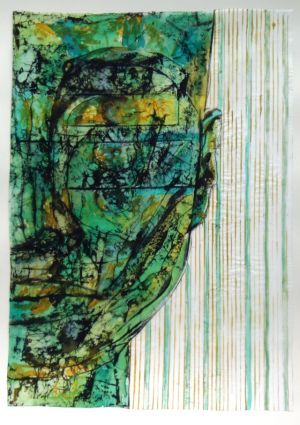Batik – painting – drawing
Extract from the article by Jolanta Antecka from the magazine SZTUKA.PL-GAZETA ANTYKWARYCZNA
 The works described as painting on silk using the batik technique Karina Rzendkowska fits in a narrow circle of contemporary European painters who use one of the oldest techniques of colorful decorating of fabrics. Creativity Silesian artist is original, exclusive part of this circle, adapted for the needs of European art of the xx century. the technique, developed earlier than a long time, the islanders of Indonesia. Thanks to Dutch trade, in the XVII century. came to Europe the first specimens batik fabric from Java. XIX century-a time of wide interest batik as a technique.
The works described as painting on silk using the batik technique Karina Rzendkowska fits in a narrow circle of contemporary European painters who use one of the oldest techniques of colorful decorating of fabrics. Creativity Silesian artist is original, exclusive part of this circle, adapted for the needs of European art of the xx century. the technique, developed earlier than a long time, the islanders of Indonesia. Thanks to Dutch trade, in the XVII century. came to Europe the first specimens batik fabric from Java. XIX century-a time of wide interest batik as a technique.
The batik technique consists, in its basic version, in covering with a thin layer of wax those places on the fabric that we want to protect against the effects of the dye. After applying wax, the fabric is immersed in paint. Repeating this treatment you can get further colors and patterns determined by the wax reserves. The classic Javanese batik was more complicated: multiple immersion of the fabric in acid baths, castor oil, leaching, washing, drying, drawing with wax, dyeing.
The Silesian artist treats the batik technique unorthodoxically. She applies a layer of wax to the silk pig iron, breaks the wax after settling and introduces a dye. Often there is only one: black, sometimes using two; the second (and in the order of introducing the first) is sometimes gray. In Rzendkowska’s technique of batik, three colours would be very prodigality with a consciously limited, disciplined range of colours, in which the vast majority of her works on silk are maintained.
After the wax has been removed and pressed, the fabric remains in one or two-coloured form with white clearances in those parts where the dye has not arrived. Now the painterly interference begins: contour, extraction of facial features from spots and veins, touching with colour.
Painting activities must be consistent with what already exists on silk. Karina Rzendkowska says that she scrupulously “reads” the original form in order to enter into a consensual painting dialogue with it.
Is there a coincidence in batik actions and to what extent?
It exists, but it does not rule; it is limited to a minimum by the skill and familiarity that the author achieves after some time of communing with this technique. With skills such as those possessed by Karina Rzendkowska, it is not only known how and where the dye will work, what can and should be created.
When organizing the surface of the painting in a visible way, the artist is guided by the rigours of a good graphic arts school; nothing that happens on a silk plate is not unimportant. Hence the insightful recognition until a common rhythm of batik and painting is found. The main (for a long time) theme is the head; more of a character than a portrait, more of a state, situation, a moment than a record of unambiguity.
Karina Rzendkowska’s paintings play out between graphic linearity, the artist’s predilection for cubicization and the soft, subtle fluidity of matter within and outside the contour, the discreet glow of silk and the light coming out of discolorations.